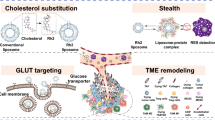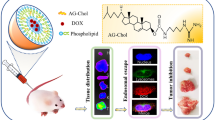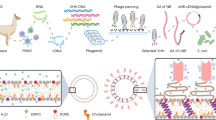Abstract
Purpose. Many tumors express elevated levels of LDL receptors (apoB, E receptors) on their membranes. Selective delivery of anti-neoplastic drugs to tumors by incorporation of these drugs into LDL or LDL-resembling particles should improve the efficacy of tumor therapy and minimize the severe side-effects. Since the apolipoproteins on the particles are essential for the LDL receptor recognition, drugs should preferably be incorporated into the lipid moiety. Most anti-tumor agents are too hydrophilic for incorporation into these carriers.
Methods. We synthesized LAD, a lipophilic prodrug of daunorubicin, by coupling the drug via a lysosomally degradable peptide spacer to a cholesteryl oleate analog.
Results. The overall yield of the synthesis was 50% with a purity of >90%. Radioactively ([3H]) labeled LAD was obtained via a slightly modified procedure (yield 40%). The octanol/water partition coeffient of LAD is 30-fold higher than that of daunorubicin. LAD could be incorporated into triglyceride-rich lipid emulsions and small liposomes, which, if provided with apoE, have been demonstrated earlier to be cleared in vivo via the LDL receptor. The liposomes contained approximately 10 molecules of LAD per liposomal particle. Analysis of differently sized LAD-containing emulsions suggests that LAD associates with the surface of lipidic particles. In the presence of human serum, LAD did not dissociate from the emulsion particles, indicating a firm association of LAD with the carrier.
Conclusions. The coupling of a cholesterol ester analog to daunorubicin results in a lipophilic prodrug that can be firmly anchored into lipidic carriers. LAD-loaded emulsions and liposomes provided with recombinant apoE will be tested in the near future for their ability to deliver LAD to tumor tissue in vivo via the LDL receptor.
Similar content being viewed by others
REFERENCES
R. A. Firestone. Low-density lipoprotein as a vehicle for targeting antitumor compounds to cancer cells. Bioconjugate Chem. 5:105–113 (1994).
M. S. Brown and J. L. Goldstein. A receptor-mediated pathway for cholesterol homeostasis. Science 232:34–47 (1986).
P.C. De Smidt and Th. J. C. Van Berkel. Prolonged serum half-life of antineoplastic drugs by incorporation into the low density lipoprotein. Cancer Res. 50:7476–7482 (1990).
M. Masquelier, S. Vitols, and C. Peterson. Low-density lipoprotein as a carrier of antitumoral drugs: In vivo fate of drug-human low-density lipoprotein complexes in mice. Canc. Res. 46:3842–3847 (1986).
G. S. Ginsburg, D. M. Small, and D. Atkinson. Microemulsions of phospholipids and cholesterol esters: protein-free models of low density lipoprotein. J. Biol. Chem. 257:8216–8227 (1982).
G. S. Ginsburg, M. T. Walsh, D. M. Small, and D. Atkinson. Reassembled plasma low density lipoproteins: Phospholipid-cholesterol ester-apoprotein B complexes. J. Biol. Chem. 259:6667–6673 (1984).
B. Lundberg, K. Hong, and D. Papahadjopoulos. Conjugation of apolipoprotein B with liposomes and targeting to cells in culture. Biochim. Biophys. Acta 1149:305–312 (1993).
R.C. Maranhão, T. B. Cesar, S. R. Pedroso-Mariani, M. H. Hirata, and C. H. Mesquita. Metabolic behaviour in rats of a nonprotein microemulsion resembling low-density lipoprotein. Lipids 28:691–696 (1993).
R. C. Maranhão, B. Garicochea, E. L. Silva, P. Dorlhiac-Llacer, S. M. S. Cadena, I. J. C. Coelho, J. C. Meneghetti, F. J. C. Pileggi, and D. A. F. Chamone. Plasma kinetics and biodistribution of a lipid emulsion resembling low-density lipoprotein in patients with acute leukemia. Cancer Res. 54:4660–4666 (1994).
P. C. N. Rensen, R. M. Schiffelers, A. J. Versluis, M. K. Bijsterbosch, M. E. M. J. Meuwissen, and Th. J. C. Van Berkel. Human recombinant apolipoprotein E-enriched liposomes can mimic low density lipoproteins as carriers for the site-specific delivery of anti-tumour agents. Mol. Pharmacol. 52:445–455 (1997).
P. C. N. Rensen, N. Herijgers, M. H. Netscher, S. C. J. Meskers, M. Van Eck, and Th. J. C. Van Berkel. Particle size determines the specificity of apoE-containing triglyceride-rich emulsions for the LDL receptor versus hepatic remnant receptor in vivo. J. Lipid Res. 38:1070–1084 (1997).
T. L. Innerarity, R. E. Pitas, and R. W. Mahley. Binding of argininerich (E) apolipoprotein after recombination with phospholipid vesicles to the low density lipoprotein receptors of fibroblasts. J. Biol. Chem. 254:4186–4190 (1979).
R. E. Pitas, T. L. Innerarity, and R. W. Mahley. Cell surface receptor binding of phospholipid protein complexes containing different ratios of receptor-active and-inactive E apolipoprotein. J. Biol. Chem. 255:5454–5460 (1980).
R. E. Pitas, T. L. Innerarity, K. S. Arnold, and R. W. Mahley. Rate and equilibrium constants for binding of apo-E HDLc (a cholesterol-induced lipoprotein) and low density lipoproteins to human fibroblasts: evidence for multiple receptor binding of apo-E HDLc. Proc. Natl. Acad. Sci. USA 76:2311–2315 (1979).
T. Funahashi, S. Yokoyama, and A. Yamamoto. Association of apolipoprotein E with the low density lipoprotein receptor: demonstration of its co-operativity on lipid microemulsion particles. J. Biochem. 105:582–587 (1989).
D. W. Henry. Adriamycin (NCS-123127) and its analogs. Cancer Chemother. Rep.—Part 2 4:5–9 (1974).
A. Trouet, D. Deprez-De Campeneere, C. de Duve. Chemotherapy through lysosomes with a DNA-daunorubicin complex. Nature, New Biol. 239:110–112 (1972).
A. Di Marco, F. Zunino, R. Silvestrini, C. Gambarucci, and R. A. Gambetta. Interaction of some daunomycin derivatives with deoxyribonucleic acid and their biological activity. Biochem. Pharmacol. 20:1323–1328 (1971).
A. Trouet, M. Masquelier, R. Baurain, D. A. Deprez-De Campeneere. Covalent linkage between daunorubicin and proteins that is stable in serum and reversible by lyosomal hydrolases, as required for a lysosomotropic drug-carrier conjugate: in vitro and in vivo studies. Proc. Natl. Acad. Sci. USA 79:626–629 (1982).
N. Umemoto, Y. Kato, N. Endo, Y. Takeda, and T. Hara. Preparation and in vitro cytotoxicity of a methotrexate-anti-MM46 monoclonal antibody conjugate via an oligopeptide spacer. Int. J. Cancer 43:677–684 (1989).
J. J. Fitzpatrick and M. C. Garnett. Design, synthesis and in vitro testing of methotrexate carrier conjugates linked via oligopeptide spacers. Anti-Cancer Drug Design 10:1–9 (1995).
K. L. Law, K. E. Studtmann, R. E. Carlson, T. A. Swanson, A. W. Buirge, and A. Ahmad. Tumor reactive cis-aconitylated monoclonal antibodies coupled to daunorubicin through a peptide spacer are unable to kill tumor cells. Anticancer Res. 10:845–852 (1990).
T. G. Redgrave, D. C. K. Roberts, and C. E. West. Separation of plasma lipoproteins by density-gradient ultracentrifugation. Anal. Biochem. 65:42–49 (1975).
R. R. C. New. Liposomes: a practical approach, IRL Press, Oxford, 1990.
S. Vitols, G. Gahrton, and C. Peterson. Significance of the low-density lipoprotein (LDL) receptor pathway for the in vitro accumulation of AD-32 incorporated into LDL in normal and leukemic white blood cells. Canc. treat Rep. 68:515–520 (1984).
S. G. Vitols, M. Masquelier, and C. O. Peterson. Selective uptake of a toxic lipophilic anthracycline derivative by the low-density lipoprotein receptor pathway in cultured fibroblasts. J. Med. Chem. 28:451–454 (1985).
P. C. De Smidt, T. Le Doan, S. De Falco, and Th. J. C. Van Berkel. Association of antisense oligonucleotides with lipoproteins prolongs the plasma half-life and modifies the tissue distribution. Nucleic Acids Res. 19:4695–4700 (1991).
P. C. De Smidt, A. J. Versluis, and Th. J. C. Van Berkel. Properties of incorporation, redistribution and integrity of phorphyrin-LDL complexes. Biochem. 32:2916–2922 (1993).
Y. Oschry and S. Eisenberg. Rat plasma lipoproteins: re-evaluation of a lipoprotein system in an animal devoid of cholesteryl ester transfer activity. J. Lipid Res. 23:1099–1106 (1982).
P. J. Barter and J. I. Lally. The activity of an estrified cholesterol transferring factor in human and rat serum. Biochim. Biophys. Acta 531:233–236 (1978).
Author information
Authors and Affiliations
Rights and permissions
About this article
Cite this article
Versluis, A.J., Rump, E.T., Rensen, P.C.N. et al. Synthesis of a Lipophilic Daunoruhicin Derivative and Its Incorporation into Lipidic Carriers Developed for LDL Receptor-Mediated Tumor Therapy. Pharm Res 15, 531–537 (1998). https://doi.org/10.1023/A:1011917508056
Issue Date:
DOI: https://doi.org/10.1023/A:1011917508056




